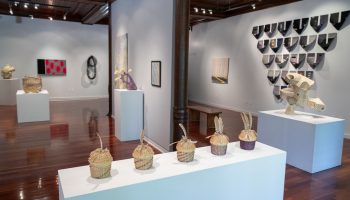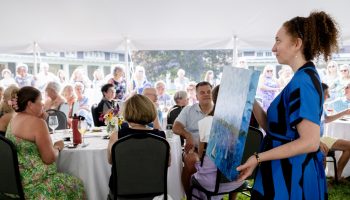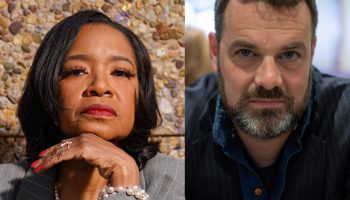
Kaitlyn Finchler
Staff Writer
Molecular biology, writing and queer theory don’t necessarily always go hand in hand, but Joseph Osmundson contains multitudes; when he delivered this year’s Writers’ Festival keynote last Thursday evening for attendees in the Athenaeum Hotel Parlor and lobby, he mined the depths of publishing, writing and exploration within the queer identity.
“I feel a little silly to be up here in front of everyone,” he said. “What I felt this entire week has so far — and we’re only halfway through — is such a network. … We’re all working together and that’s one of the things I want to talk about tonight.”
Osmundson’s keynote took place on the second day of the festival, which at that point had included an introductory session, welcome address, workshops and a craft panel where all attendees were in a collaborative space. Osmundson was as much a participant as he was a guide for the writers in attendance.
Osmundson — not a morning person, he said — likes to start his day around 10 to 11 a.m., cup of coffee in hand. He’ll sit out on the balcony in the shade and appreciate where he’s at in life through mindfulness and meditation. Then, he recognizes the current state of the world. As an example, one morning he received a text from one of his friends that simply said “THE BREEZE.” So he started to think about the breeze.
“On this day, this Saturday, the temperature of our planet has risen nearly two degrees Celsius and it’s still going up,” Osmundson said. “Last year, it was the hottest year on record.”
Osmundson listed other disasters, both political and natural, in the world. The land war in Europe, a headline in 2018 tying the U.S. to civilian deaths in a “not-so-civil civil war.” The Mpox virus “that could have been contained in the Democratic Republic of Congo, Nigeria, instead became deadly worldwide.”
Next, 90% of deaths in America are from advanced HIV; then 263 mass shootings in America so far in 2023 — almost two mass shootings a day. He then went on to mention the 30 million Americans, nearly 10% of the population, who don’t have health insurance.
“Things are not going great, and we have news and social media cycles that actually profit off of this constantly,” Osumundson said. “Yet, for many of us in this room, we sit on evenings or on Saturdays, we’re overworking and being underpaid, exhausted by the world around us.”
Osmundson said writing is a way to light the fire people have inside them, and attempting to be published is not inherently better than journaling.
“We sit down in a world on fire and write,” he said. “I want a positive act of hope and belief in the world, and then we can actually change it.”
Osmundson introduced to his audience the two-way gravity interaction metaphor, how the amount of gravity exerted depends on the mass. Consider Earth’s massive mass, and one develops a much more massive view.
“Can we all collectively exert that gravity in the same direction that actually changes the course of how we write?” Osmundson said. “In a way, we have not given up. The world’s really depressed. … I’m depressed because I’m hopeful, because I do believe that the world can be materially better.”
Next, he asked a series of questions, with participants keeping their hands raised in the affirmative. “Raise your hand if you make art.” “Keep them raised if part of that art is writing.” “Keep them raised if part of that art you think about publishing.” Hands started to lower.
“Keep them raised if you write because of the desire to impact not just yourself, but the world around you.” Everyone’s hands were raised.
“We are collective in our belief that our writing can be gravity that exists for some person,” Osmundson said.
Art can change the world, and he knows this because “art has changed my world.” He borrowed an explanation from his day job as a molecular biologist to reinforce the point of things being necessary and also sufficient.
“It is possible for something to be necessary but not sufficient,” Osmundson said. “Art may be necessary to change the world, but without activism … it is not going to do that.”
He encourages people to think about art as part of their individual and collective work to change the world.
“I do believe that time to take in and make art should be a human right,” Osmundson said. “We are humans with messy connections and desires and experiences. We are not simply workers or cogs in the machines of capitalism.”
People should let the messiness show, he said, and connect with others in solidarity of creation and community.
“We can plug this in as a piece of the puzzle to making the world fundamentally different,” Osmundson said.
The possibility of what can be is large, he said, and for him that was the “homosexual possibility.”
“When I was younger, I literally didn’t know that I was possible,” said Osmundson, who grew up in the early ‘90s in a small, western logging town. He didn’t know what it meant to be a scientist, or that people spent their lives experimenting.
“Doctors and writers were old and white and straight and dead,” Osmundson said. “At that time, Dickens and Austen saved my life. I couldn’t imagine being a writer was a possibility for me.”
In high school, Osmundson said he loved Sophocles’ Antigone so much he asked his sophomore English teacher if he could assign it to the class himself and give a lesson “on the uses of symbols and foreshadowing and its assignment of moral planning — I was not exactly what you would call popular.”
In his sophomore year of college, he read The Lover, by Marguerite Duras, about an illicit affair between a teenage French girl and a wealthy, older Chinese man, in which the girl discovers her sexual desire for both men and women.
“She identifies as ‘queer,’ but she sees love and hate and pleasure and disgust overlap,” Osmundson said. “She expressed my sexual desire without any identity; this such sexuality is not mentioned.”
This book and this character, he said, unlocked something for him.
“It unlocked the possibility that I could be attracted to more than one gender,” he said, and he proceeded to read an excerpt from the book.
“(The character) wants to create a scene where her male lover and her small crush come together and enact a desire that is forbidden,” Osmundson said. “This was among my first steps into the possibility of queerness.”
While he always loved women, he said if he had not read this book, he never would have had the opportunity to question, observe and reject heteronormativity.
“(Authors’) confrontation with their empty pages in the 1980s helped me be clear in a way that I love about myself three decades later, and God bless them,” Osmundson said.
The writings of various theorists have made his understanding of gender and sexuality much clearer, like Judith Butler’s notion of gender as performance, and natural gendered behaviors. Queer gender is just as performative as normative gender, he said. It’s just that “normative gender gets to name itself as nonperformance,” he said. “These men driving around with gun racks in the back of their trucks” are performing gender as much as any queer person.
American academic Jose Esteban Munoz put forth a notion of queerness as a utopia — not that queer people are without struggle, Osmundson said, but the queer life now is a utopia compared to the life of queer people in the ‘80s and ‘90s.
“Language created us,” he said. “Language has done to us, before we do language. We have to recognize that we must learn to manipulate language, perhaps in ways that destabilize how we learn language so young.”
By creating new language in front of the world, writers can remake that world.
“There is hope in this — that art, and hearing, and writing, can make the world different for those who make and consume it,” Osmundson said.
But hope isn’t always enough. Osmundson recalled a conversation with his friend Julian Watkins, a Black, gay doctor who specializes in sexual health. Watkins pointed out that queer people now are living their predecessors’ utopia, and while there is new hope for the trans and queer community, that hope — without action — can lead to a failure of empathy.
“Empathy alone is not enough to, obviously, just feel bad about racism or sexism or homophobia,” Osmundson said. “Empathy has to be an initiative that acts to something. That’s the difference between solidarity and empathy.”
Writing, he said, is a nucleation point for empathy, and the way people interact with books and community can build the solidarity needed for action — “the desire not just to understand, but to do, to walk towards a world-leading utopia where queer people aren’t treated as they were in Giovanni’s Room,” he said. In James Baldwin’s book, the only possibilities for queer people were “straightness and misery or queerness and death.”
From Antigone to The Lover to Giovanni’s Room, “these books show the full sweep of humanity and build the validation for solidarity that insists on maximizing pleasure and safety and minimizing violence,” he said. “All because humans deserve pleasure and safety.”




